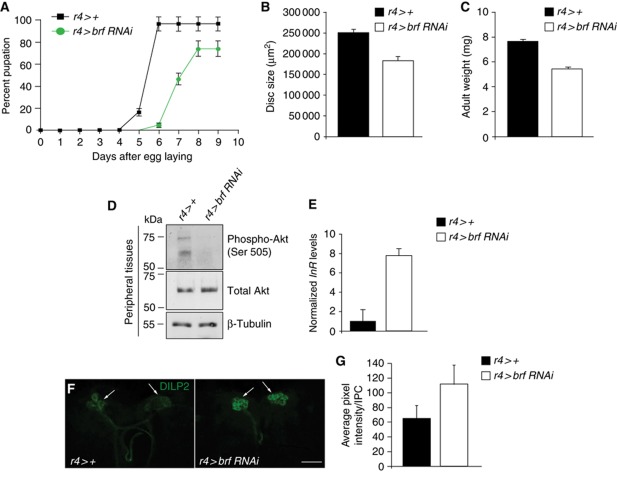Figure 2.
Fat body-specific reduction in Brf activity has cell non-autonomous effects on organismal growth and development. (A) Fat body-specific reduction in Brf levels (r4>brf RNAi, green trace) delayed pupariation when compared with controls (r4>+, black trace). The data are represented as a percentage of larvae that develop to pupal stage. Error bars indicate s.e.m. (B) Fat body loss of Brf function results in smaller wing imaginal discs, compared with controls (n>20 per genotype). Disc size was quantified in wandering third instar larvae using the histogram tool (Adobe Photoshop). Error bars indicate standard error. (C) Reduced Brf in the fat body reduced adult weight compared with control adults. Error bars indicate standard error. (D–G) Silencing of brf specifically in the Drosophila fat body decreased peripheral insulin signalling. (D) brf silencing in the fat body abolished Akt phosphorylation at serine 505 in peripheral tissues while total Akt protein levels remained constant. Levels of β-tubulin were measured to ensure equal loading. (E) Decreasing Brf levels specifically in the fat body using the r4-GAL4 driver significantly increased dInR mRNA levels in peripheral tissues of these animals when compared with controls (P<0.05, Student's t-test; n=32 per genotype). All qRT–PCR error bars represent s.e.m. (F) There is an accumulation of dILP2 protein in the IPCs of r4>brf RNAi larval brains compared with controls (r4>+). (G) Quantified pixel intensities of DILP2 staining in IPC clusters in the larval brain (r4>+, n=12 and r4>brf RNAi, n=21; error bars represent standard deviation; P=000174). For (D–G), larvae were analysed at 96 h AEL.

